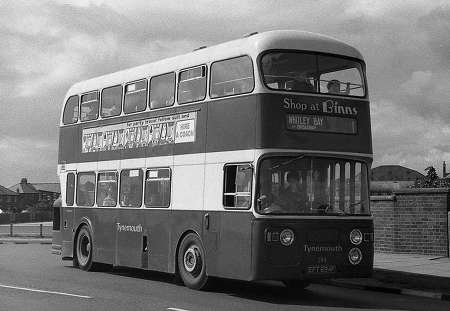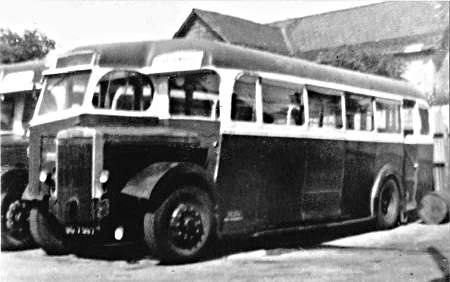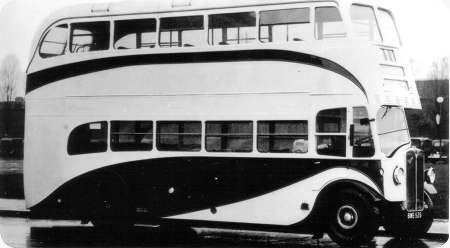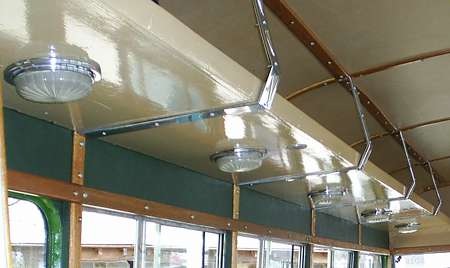Tynemouth and District – Leyland Atlantean – FFT 757 – 257
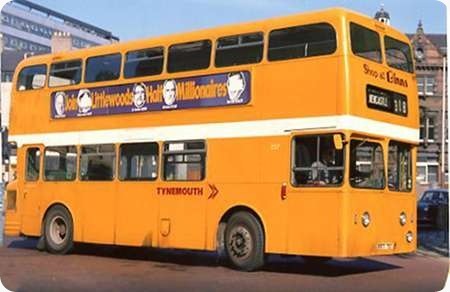
Photograph by ‘unknown’ if you took this photo please go to the copyright page.
Tynemouth and District
1962
Leyland Atlantean PD1/1
Roe H44/33R
The early PDR1/1 and PDR1A/1 Leyland Atlantean’s have long been a point of discussion, and I was never a fan of them. The NGT Group had around 250 and the majority were Roe bodied, but they also had Weymann and Metro Cammell as well as the early and later type Alexander, then after NBC was formed they were allocated a hand full of ECW’s. Before depot fleets started to be changed around, Percy Main had 22 in total, 9 Metro Cammell, CFT 936/44 – 236/44 (‘240′ is posted elsewhere on this site), and 5 Roe DFT 245/9 – 245/9 all came in 1960. then another 8 Roe’s arrived in 1962, FFT 754/61 – 254/61; one Metro Cammell ‘236’ and two Roe ‘254/5’ carried the Wakefields name. The rest of the group continued to order Leyland, but in 1963, Percy Main became the first to order the infinitely superior Daimler Fleetline. I never heard any adverse comments about the build quality of either body, and at first glance the did look rather similar, but to me the Metro Cammell looked more balanced and better proportioned than the Roe, but both did look rather smart in Northern’s livery. As for NBC, well the poppy red was bad enough, but this version of Tyne & Wear PTE yellow didn’t do anything any favours. 257seen above still carried the Tynemouth name, and all NGT subsidiary names were made defunct in 1975, so the photo predates that, but look how far the standards of the one immaculately turned out Tynemouth and District fleet have fallen post NBC. e.g., on this one the wheel trims are missing, on others badges and body trim weren’t replaced when repairs were carried out, and sometimes repaired areas stuck out like a soar thumb, and in general the fleet just looked shabby. I don’t know if this was common throughout NBC, but it certainly was in this area, and both NGT and United suffered. Was it because pride in the company had been lost, poor management, cost cutting, or a combination of all of those factors? The current Northern ‘Go Ahead Group’ management seem to be making an effort and the fleet seems to be well cared for, but the glory days are long gone.
Photograph and Copy contributed by Ronnie Hoye
09/04/13 – 16:50
NBC became to stand for No Body Cares – at least as far as vehicle looks were concerned. This was apparent from the start with an eminently forgettable and fadeable poppy red, the dullest green in living memory and a dirt attracting white being chosen for the fleet colour choices. After that it was all down hill.
Phil Blinkhorn
09/04/13 – 17:43
Superior Daimler Fleetline…………did you drive these vehicles? The Daimler Fleetline was a very poor bus compared to a Leyland Atlantean. The Fleetline may have been more economical but when you could get an engine to perform as poorly as this it’s bound to be more economic than the Leyland which was superior in every way.
Michael
10/04/13 – 06:50
The early rear engined buses were all "inferior" in their own way but only the PDR1/2 excelled the PDR1/1 in the inferiority stakes. The improved AN68 tackled most problems and produced the best 1st generation rear-engined vehicle – and was succeeded by a real classic, the ON Olympian. The Fleetline was more reliable than the PDR1/1 and in almost every way superior to the PDR1/2. Leyland should have concentrated on the Fleetline, rather than the PDR1/2, for low floor buses. It was arguably better even than the VRT which was a late entrant and should have learned by its competitors early mistakes. Perhaps the best first generation line up should have been what almost happened. "Leyland" Fleetline available with choice of O.680 or 6LXB (which did happen) for low-floor and Leyland Atlantean AN68 or AN6LXB for standard height?
David Oldfield
10/04/13 – 11:06
David, the PDR1/2 first appeared in 1964 with a drop centre rear axle bought from Daimler. Why Daimler allowed its, at the time, only serious competitor to purchase what could be seen as its major competitive asset, especially in the race for NBC Group sales, is probably down to the attitude of Sir William Lyons to Daimler as a whole and to Jaguar’s need to improve cash flow in an area in which it had no previous expertise and which it perceived as a piece of saleable engineering rather than a proprietary product to be protected.
Leyland didn’t get its hands on the Fleetline until 1968 when it merged with Jaguar/Daimler’s then owners British Motor Holdings. By then Leyland, as the major component of the merged company, was working on the design of the AN68 and, having added the Fleetline to its stable, had no need to do anything other than support the PDR1/2s in service, the type having been withdrawn from the catalogue in 1967.
Phil Blinkhorn
10/04/13 – 17:28
Sorry, Phil, but NBC did not embrace poppy red, leaf green and washday white liveries from the start. For the first three years, companies were left alone to run things much as before in most respects, including that of liveries. The rot set in with the appointment as chairman of glue manufacturer and failed Tory parliamentary candidate, Freddie Wood, in 1972. Centralisation then became the policy that apparently befitted "The Biggest Bus Company In The World". Thenceforward, all material decision making was undertaken at the "top", much of it in collusion with another over promoted egotist, Donald Stokes of Leyland. That’s when things went wrong, and the bus industry is plagued by the same attitudes today. Local managers of companies in the big groups have very limited freedom of manoeuvre. Profit margins form the only parameter of importance to the present day City driven transport groups. Profit first – passengers nowhere. After a working lifetime in the bus industry, I have now totally given up on my local bus operator and use my car. The northward extension of the much vaunted Cambridgeshire "Busway" service (on ordinary roads, that is) results in our village getting an hourly ‘service’ that runs anything up to an hour late. Letters to the local company go unanswered. NBC is dead. Long live NBC.
Roger Cox
10/04/13 – 17:28
I used to like the Jones of Aberbeeg NBC livery, Dark Blue with white lettering and on some vehicles, white trim. It was a subsidiary of Red & White but never bore those colours.
Orla Nutting
10/04/13 – 17:29
Within the Municipal fleets, politics had a great influence. Some would support only "ABC" because "ABC" buses were built locally, while some of their neighbours couldn’t stand the things and bought only "XYZ". They even refused to have demonstrators visiting. Such things have been discussed in these columns before.
My own local fleets in my formative years were Lancaster, Morecambe & Heysham, and Ribble. By the mid to late 1960’s, Lancaster was largely Leyland, but there were still some stragglers from Wartime deliveries. Next door, Morecambe & Heysham were very staunch AEC supporters and nearly all of us know about Ribble’s buying pattern!
In Birmingham, in my student days, most of the fleet was from Daimler, but Guy and Leyland were there as well. In Southampton, the Atlantean was arriving by 1970 when I moved down here, replacing the vast number of Guy Arabs. Southampton had only ever had one Daimler. The fleet history declares it to have been "unsatisfactory" and was returned to the maker. The Council didn’t want to know after that, although they did host visits by a couple of Fleetlines in 1964.
Coventry is famous for the dispute after Atlanteans were ordered rather than Fleetlines.
I like Ronnie’s comment about what the current management at Go Ahead are trying to achieve in respect of presentation. I am familiar with their operations in Dorset, Hampshire, Wiltshire and the Isle of Wight. For the most part, vehicles are clean and tidy, but the liveries are a bit garish!
Pete Davies
11/04/13 – 07:43
Roger you are quite correct about the date of the livery introduction, something I have always known and which I always place as the start of NBC’s real hold over its constituents – something I should have made plain. Again you are correct about Wood and Stokes, two classic examples of the failure of the dogma, still existing in many businesses, that a successful manager in one industry can be equally successful in another even though they have little knowledge and experience in any other field but their own.
Phil Blinkhorn
11/04/13 – 07:44
Pdr/1 Atlanteans in the potteries fleet were on the heavy loaded services and also hilly services and also did express services during holiday times they were a drivers bus and very reliable. Fleet lines were to slow having problems with fluid throttle linkages and the driving position was very poor in relation to the swept area of the windscreen in the wet, all in all they were crapp.
Michael driver of 47 years experience
11/04/13 – 07:44
Pete mentions municipal buying policy my local operator Leeds triple sourced chassis and doubled sourced bodywork How much this kept the various suppliers up to the mark is anyones guess but it kept ones interest going.
Chris Hough
11/04/13 – 16:13
Yes, Michael, I have driven Fleetlines a mile or several thousand, and I don’t retract a word of what I said. The only PDR1’s we had were the 22 mentioned in my posting. I left T&D in 1975, just as the AN68 was coming into service, but they were mostly used on OPO routes and my experience of them is limited, so I cant comment. The Atlantean was faster than the Fleetline, and no doubt would be better suited to some routes, but the superior lower end torque of the 6LXB made the Fleetline a far better vehicle for the stop/start high volume routes we had at Percy Main. I can count on one hand with fingers to spare, the amount of times I broke down with a Fleetline, I lost count with the Atlanteans.
Ronnie Hoye
12/04/13 – 07:55
Phil,
The Atlantean PDR1/2 used the drop centre rear axle developed by Leyland for the ‘Albion Lowlander’. This had to be modified to allow the drive to come in from the offside rather than the nearside as on the Lowlander. What Leyland bought in from Daimler was the Fleetline gearbox, as the Leyland gearbox couldn’t be used with a drop centre axle. This changed with the PDR1/3, the successor to the PDR1/2, that had the same Leyland drop centre axle but used the rationalised Leyland pneumocyclic gearbox.
Michael Elliott
12/04/13 – 07:58
As well as allowing them to retain their names and liveries, NGT’s management of its subsidiaries also encouraged them to order what they wanted, rather than something head office said they should have; and so it was that in 1963 Tynemouth and District took a completely different course to the rest and became the first depot to take delivery of the CRG6LX Daimler Fleetline. They had 35 in total, the first 15 were Weymann bodied.
1963 – HFT 366/75 – 266/75 H44/35F
1964 – JFT 276/80 – 276/80 H43/32F
The stair layouts accounts for the different capacities. 
JFT 280 is shown here in its original livery and is from the 1964 intake. I’ve mentioned before that T&D had very high standards, so at the time the photo was taken 280 must have been due for a repaint, otherwise, that replacement side panel next to the rear wheels would never have been left like that. Note the layout of the stairs, to me they are the wrong way round, and I doubt if they would be allowed today. Anyone ascending them is going towards the rear of the vehicle rather than the front. In a worst case scenario, if someone is on the stairs and the driver for whatever reason has to brake sharply, they have only one way to go, and that is in the direction of down, whereas, on a more conventional layout they will either fall ‘up’ the stairs or end up on their backside sitting on them. Apart from the added risk factor, the seating capacity has been reduced by four, so I don’t see the point. perhaps whoever thought of it looked on it like the invasion of Russia ‘it seemed like a good idea at the time’
The remaining 20 had the superb H44/34F Alexander body.
1965 – AFT 783/9C – 283/9
1967 – DFT 290/2E – 290/2
1968 – EFT 693/702F – 293/302
If memory serves, the 1965 intake had electrically operated doors whilst the rest were air, but that apart their were very few differences between them. In 1966, T&D again broke ranks and adopted a much simplified version of the 1940/50’s NGT livery, other depots soon followed suit, and I believe one of the Routemaster’s is preserved in this livery. The 1968 intake were the last D/D’s ordered by T&D before they became part of NBC. As with all vehicles, some will swear by them while others swear at them, but very few drivers disliked them. The Fleetline were not the fastest buses in the depot, but they were perfect for stop/start town routes. The utterly reliable Gardner 6LX was arguably the best engine of its generation, and what it lacked in top speed, it more than made up for at the bottom, even with a full load, they were quick off the mark and never struggled to keep pace with traffic. The Alexander bodies were smart, well designed, and extremely well built; they had good all round vision with minimal blind spots, and switches and controls were all within easy reach, they also had a level of comfort that made them popular with both passengers and crew alike; The Daimler chassis had good brakes and light positive steering, it was very forgiving and exceptionally well behaved. This was a time when buses still had leaf springs, but the ride quality was as least as good as any of today’s buses. I left Percy Main shortly after the first AN68’s began to arrive, so my experience of them is limited, they were unquestionably better that the PDR1/1’s I had previously driven, but were they the best bus of their generation? The bus chassis division of British Leyland was an amalgam of AEC – Bristol – Daimler – Guy and Leyland, and while some would argue that the AN68 was a success because it sold in huge numbers, the creation of NBC meant it had a guaranteed market with little or no competition. Rather than being allowed to develop. BL saw the Olympian – Fleetline and FRM as rivals to the AN68 and couldn’t wait to kill them off, the same thing happened to any competition to the Leopard or National. I can only speak for myself. but for my money, up to 1975, the Alexander Daimler Fleetline, was, and still is the best rear engine bus I have ever driven.
Ronnie Hoye
12/04/13 – 12:17
Ronnie, re the stairs see my article Days Out with Martin Hannett.
Michael, I’ve done a check back and it seems that there are a number of instances in print from the time that allude to the axle being Daimler but The Leyland Bus states categorically that the axle WAS Leyland. The rest of the drive change was made by Daimler and was modified as you indicate. Thanks for the correction.
A bit more digging shows that the Daimler gear box was built to a design by Self Changing Gears, which Leyland owned, so Lyons was basically selling Leyland a product it actually owned – clever!
Phil Blinkhorn
12/04/13 – 14:43
With reference to Ronnie’s remarks on the orientation of the stairs on front entrance double deck buses, I recall travelling home to Jarrow from North Shields after a night watch. Having almost dozed off on the top deck I realised that the bus was approaching my stop and I needed to move with haste. From memory, and it was a long time ago now, I rushed down the forward facing stairs as the driver negotiated a slip road and braked for the stop with the result that I was propelled towards the exit at a rate of knots. Fortunately the bus stopped and the doors opened so that I was ejected on to the pavement past the waiting passengers without further incident, though some of the people waiting we’re neighbours who were a bit surprised at my sudden arrival. So I can only endorse the remarks about the dreaded "health and safety" and the positioning of the staircase.
Stan Zapiec
12/04/13 – 17:14
Yes, Stan – forward-facing stairs were always a safety hazard, but at least (in the case of the Fleetlines you referred to) a flying passenger would tend to hit the bulkhead behind the driver. On the infamous Wulfrunians, with their nearside forward-facing staircases, a passenger could end up straight through the windscreen. I have memories of being propelled forward on a number of occasions following an over-enthusiastic brake application. This, combined with their distinctive rolling and pitching movement, made life very interesting for unsuspecting passengers.
Paul Haywood
13/04/13 – 07:43
I’m not sure when forward ascending staircases were introduced on rear engine chassis. All the PMT double deckers up to and including the 1965 Alexander bodied Fleetlines were rearward ascending. Sheffield used rearward ascending until dual door double deckers became standard from 1969. In Huddersfield it was only the introduction of dual entrance bodies in 1970 that first saw the use of forward ascending ones. I suspect this was common with many other Operators. Once the fad for dual entrance buses faded the forward ascending type become the norm on single doorway buses.
Ian Wild
13/04/13 – 07:44
According to Alan Townsin, Phil, the Daimatic direct selection gearbox fitted to CV and Fleetline chassis was entirely a Daimler design which differed internally from the original Wilson principles, notably in respect of the brake bands. It is possible that these changes were made to avoid claims that the gearbox was a copy of the 1954 SCG gearbox design used by Leyland (Pneumocyclic) and AEC (Monocontrol). Self Changing Gears was not fully controlled by Leyland until 1957 when it bought a third of the company’s shares from Hawker Siddeley to add to the third it had owned since 1951. The Daimatic gearbox had weaknesses that were never fully resolved, and the much criticised redesign undertaken later by Leyland was an attempt to remedy some of the problems. On the subject of the relative merits of early Atlantean and Fleetline buses, in 1965 London Transport decided to evaluate the rear engined / front entrance concept, and, with fully characteristic open mindedness, ordered fifty Atlanteans and just eight Fleetlines. When the Fleetline revealed its superiority, the LT engineering top brass would not accept the evidence, claiming that Fleetline in Country Area service received a much easier life than the Central Area Atlanteans. The eight Fleetlines then went to the Central Area in exchange for eight Atlanteans which were duly despatched to the Country Area. In the Central Area, the Coventry product demonstrated its superiority even more convincingly, and the pro Leyland prejudice collapsed like a punctured balloon. Not that LT learned a great deal in the end – it then went sleepwalking into the DMS fiasco.
Roger Cox
13/04/13 – 07:45
Paul although the Wulfrunian was an idiosyncratic chassis. However the nearside staircase was also used by Tyne and Wear on their dual doored Atlantean.
Chris Hough
13/04/13 – 07:45
Surely all early front-entrance double deckers, and all forward-entrance ones, had rearward-ascending staircases, didn’t they? The first ones with forward-ascending were those with centre exits. In the meantime Manchester had invented the curved staircase (I think that was on the second batch of Fleetlines) in place of the original type with two right angles. Not only was this felt to be safer, but, since one-man operation of double-deckers wasn’t even on the horizon then, the inside of the curve gave the conductor somewhere to stand.
Peter Williamson
13/04/13 – 10:09
Roger, that information from Alan Townsin conflicts with that published in The Leyland Bus.
To quote Doug Jack on page 325:
"It was also necessary to replace the normal Atlantean gearbox by using a similar gearbox built by Daimler to SGC designs…. The use of an apparently Daimler gearbox was acceptable because Leyland had owned Self Changing Gears since 1956. However the Coventry subsidiary continued to build gearboxes for Leyland’s competitors and indeed allowed Daimler, AEC and Bristol to manufacture under licence."
Whilst Alan is indeed a well respected expert, Doug Jack worked at Leyland from 1966 eventually becoming legal advisor and then Secretary of the Truck and Bus Division. The Leyland Bus was first published in 1977 whilst he was still Secretary so, presumably, he had full access to the company records.
Phil Blinkhorn
13/04/13 – 12:09
Not in our case, Peter, I’ve listed all Percy Main’s early Atlantean’s and Fleetline’s above, and only five ‘JFT 276/280’ had this type of staircase, the remainder had the more normal type where you are going towards the front when you go upstairs
Ronnie Hoye
13/04/13 – 18:37
Sorry folks, before anyone puts finger to key, I stand, or rather sit corrected. a quick memory check says the Atlanteans and Weymann bodied Fleetline’s both had rear ascending stairs, but I’m sure the Alexander bodies were forward facing, and had a luggage rack behind the driver which was over the wheel arch and under the stairs. The problem with 276/80 was that rather than two 90 degree turns, the stairs had a longer 180 degree half circle, so in effect there was nothing to stop anyone from falling from top to bottom
Ronnie Hoye
13/04/13 – 18:38
The problem I could add with forward ascending can be seen today- loss of space downstairs & that mysterious panelled space under the stairs. Driver’s bunk? What you gain in safety on the stairs you lose when "lower saloon" passengers are pitched forwards by the g force of dodgem driving. The old Roe platform staircase seemed very safe, as you fell onto a large half landing when unbalanced by the acceleration of a PD1…..
Joe
13/04/13 – 18:38
Sheffield’s early (1959-1968) Atlanteans and Fleetlines were all rear ascending.
David Oldfield
14/04/13 – 08:13
Didn’t some late-model Bristol-ECW Lodekka FLFs have forward ascending staircases? Would they have been the 31ft models? The evidence/answer must be on my bookshelves, but I’m away from home at the moment . . . I seem to remember rearward ascending staircases on Halifax/Calderdale NCME-bodied Fleetlines, then forward ascending staircases on WYPTE standard Roe-bodied Fleetlines and NBC Park-Royal/Roe Atlanteans, but ECW remaining faithful to rearward staricases on VRTs at least, and I think Atlanteans.
Philip Rushworth
14/04/13 – 08:13
It all just goes to show that buses with doors at the front and engines at the back are flying in the face of nature. It was never meant to be!
Stephen Ford
14/04/13 – 18:24
Phil, I note your comments, but all the preselector and two pedal semi auto gearboxes prior to the invasion of Allison, Voith and ZF type transmissions were built using the established epicyclic principles of Major Walter Wilson, who founded what later became Self Changing Gears with J.D.Siddeley in 1928, under the original name of Improved Gears. Leyland had no input, other than a financial holding from 1951 onwards, into those established designs, which were licensed to AEC, Daimler, Guy and Leyland, plus a number of car manufacturers. Leyland, like Daimler, may have chosen to modify some aspects of the design internals to suit its requirements, and the actuating system did differ between individual manufacturers, but the fundamental epicyclic gearing principle was wholly Wilson’s. Leyland took control of SCG in 1957, the year of Major Wilson’s death, not 1956, so the Leyland Journal has a factual error there. Sadly, the 1960s were a time when Leyland’s megalomania was at its height, so it comes as no surprise that it should endeavour to claim credit for almost everything under the sun during those years.
Roger Cox
 Vehicle reminder shot for this posting
Vehicle reminder shot for this posting
15/04/13 – 07:24
On the subject of gearboxes, Roger, some of the early Atlanteans had an alarming habit of trying to break the high jump record whenever first gear was engaged from stationary. The way to counteract this was to engage second, then when you felt the gear go in, go straight through into first. Not best practice I admit, but it worked.
Ronnie Hoye
15/04/13 – 07:26
Roger, all you say about the genesis of the gearboxes is correct but I think you are missing the point I’m making. Leyland owned 100% of Self Changing Gears in 1964 so the purchase of a gearbox built under licence by a then competitor, the licence being granted by a company Leyland 100% owned, seems both a nonsense and a coup for Jaguar.
Is there any reason the SCG could not have built the boxes for the Atlantean themselves?
As to the date of Leyland’s 100% ownership, it seems curious that Doug Jack, given his position in Leyland at the time he first published what is acknowledged to be THE definitive volume on the Leyland Bus, didn’t correct his statement in either the 1984 or 1992 editions as, by the time the latter was published, he had had 15 years to correct his "error" and thousands would have had chance to point it out.
I wonder if there is some misunderstanding somewhere of arrangements between the parties and the formal, legal transfer.
As to Leyland’s megalomania, I think it very unfair to tar the company with that brush throughout the 1960s. When the "real" Leyland Motors bought into or bought out companies, it was part of the usual cut and thrust of competitive business. The megalomania only came in with the setting up of British Leyland which was a nonsense in every respect and would have been equally so had there been no car division. What the Wilson Government seemed to want to achieve is what Attlee failed to do in the nationalisation of 1948, i.e. nationalise the production of road transport vehicles along side the nationalisation of the greater part of the geographical spread of the public transport providers in the UK
Phil Blinkhorn
15/04/13 – 17:50
I cannot agree with your view of the underlying reason for the formation of BLMC in 1968. At that time, BMC was close to disintegration through inept economic management – for example, the Mini sold for less than it cost to produce – and poor market perception. Fearful of the wider economic effects of industrial collapse in much of the West Midlands, the Wilson government persuaded Donald Stokes to take over BMC. It formed no part of a longer term desire to nationalise road vehicle production, and Attlee certainly had no such objective. The subsequent state takeover became a necessity for survival when the BLMH empire in turn faced failure. The later Heath government, despite its trumpeted Selsdon "lame duck" policy, took a similar view when Rolls Royce faced collapse in 1971, and full nationalisation again seemed the only answer. The ultimate Leyland story is one of the great ‘might have beens’, but economic policies are always easier to apply with the benefit of hindsight.
Back on the gearbox discussion, Daimler had been making vehicle preselectors under SCG licence since 1930, and unquestionably contributed greatly to the financial security of the SCG company. In addition to its own vehicles, Daimler supplied the gearboxes for the London AEC fleet until Southall was able to manufacture for itself. Possibly, by the late 1950s, Leyland recognised the great experience of the Daimler company, and bought in these units rather than expand in house production which might have led to initial teething troubles. We can but conjecture.
Roger Cox
16/04/13 – 08:16
Without wanting to turn this thread into a debate on the history of UK politics, Attlee was elected in 1945 on a platform of nationalisation based on the later notorious Labour party Clause 4. Road transport was an area which proved particularly thorny to nationalise. As early as the end of 1945 the Cabinet dropped any thought of nationalising the vehicle industry en masse, hard fought campaigns by BET and municipal transport departments reduced the intended coverage of the 1947 Act so that the only chassis manufacturer to be included was Bristol and only the Tilling Group and London Transport were nationalised.
Phil Blinkhorn
Quick links to the - Comments Page - Contact Page - Home Page
